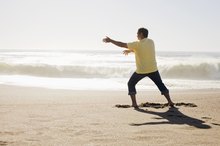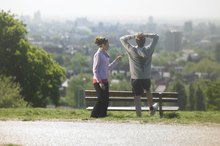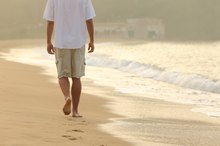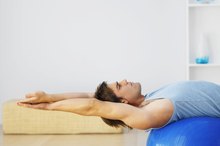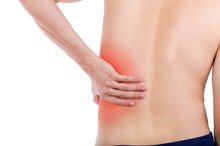Pilates for Piriformis and the Gluteus Medius
The Pilates method is a physical fitness program based on improving strength, balance, flexibility and mobility. According to the Pilates Foundation UK, Pilates may help improve your posture and promote more efficient movements. You can use specific Pilates movements to strengthen and tone your piriformis and gluteus medius muscles, which may help alleviate conditions like sciatica and piriformis syndrome. If you suffer from back pain or symptoms of sciatica, consult your doctor before performing Pilates.
Relationship of Piriformis and Gluteus Medius
The muscles of your posterior leg region include your piriformis, gluteus medius, maximus and minimus muscles and your hip rotators. Your piriformis muscle is a small muscle deep within your buttocks, below the gluteus medius. The gluteus medius helps keep your pelvis in an upright position while standing. If your gluteus medius muscle is weak, your piriformis muscle must compensate to keep your body in a stable position. This overcompensation can cause tightness and compression, ultimately leading to conditions like sciatica and piriformis syndrome. According to chiropractor Nick Campos, strengthening these weak muscles can help prevent and alleviate piriformis syndrome.
About Piriformis Syndrome
Tai Chi Exercises for the Sciatica Nerve in the Back
Learn More
Piriformis syndrome is a condition caused by a shortening or tightening of your piriformis muscle. When this occurs, your piriformis presses against your sciatic nerve, resulting in a number of troublesome symptoms, collectively known as sciatica. These symptoms include feelings of tenderness in your gluteal muscles, sharp, shooting pains down your leg, pain after extended periods of sitting, pain walking up stairs and limitations in your hip's range of motion.
How Pilates Can Help
Many people experience relief from back pain conditions such as sciatica and piriformis syndrome through mind-body exercises such as Pilates. According to NYU Langone Medical Center, Pilates may benefit conditions such as sciatica by improving posture and movement habits, but there is no clinical evidence to support its effectiveness. Specific stretching and strengthening Pilates exercises help increase strength and flexibility in the core muscles that support your posture, including all of your gluteal muscles and the piriformis.
Suggested Exercises
Causes of Nerve Pain in the Hip & Leg
Learn More
According to the Australian Pilates Academy, specific stretches for your piriformis muscle include the pigeon pose and the seated piriformis stretch. Pilates exercises that focus on your gluteus medius and the entire gluteal area include the clam, the clam kickout, leg circles and the kneeling side kick. Pilates exercises that promote postural awareness on the mat or using a Pilates ball can also provide benefits for your piriformis and gluteal muscles.
Related Articles
References
- Pilates Foundation UK: Pilates for Life
- Dr. Nick Campos: Piriformis Syndrome: A Real Pain in the Butt
- Spine-Health: Symptoms and Diagnosis of Piriformis Syndrome
- NYU Langone Medical Center: Sciatica
- Australian Pilates Academy: Piriformis Syndrome and Effective Piriformis Muscle Stretches
- Studio Pilates: Blast Your Butt
Writer Bio
Ashley Miller is a licensed social worker, psychotherapist, certified Reiki practitioner, yoga enthusiast and aromatherapist. She has also worked as an employee assistance program counselor and a substance-abuse professional. Miller holds a Master of Social Work and has extensive training in mental health diagnosis, as well as child and adolescent psychotherapy. She also has a bachelor's degree in music.
